What’s next for networking, post-pandemic?

Networking – some professionals love it, others less so, but it’s vital for making connections in any business sector. And as networking events become ever-more inventive and technologically advanced, it might even be possible to convince the haters to change their minds.
After over a year of not being able to connect in person, event planners need to think carefully about how to organise networking events post-pandemic. Many delegates are raring to get back out there, but others will be more cautious, or unable to travel across borders.
We’ve all been starved of interaction this past year, and it’s become clear that connection is much easier in person than online. Networking means sharing ideas, gathering leads and broadening our networks; meeting new people fires our creativity and leads to fruitful collaboration.
Some professionals might be thinking of moving jobs or recruiting new talent, and want to scope out contacts; others may be looking for a like-minded business partner or to get a different perspective on a work challenge.
Online networking has its problems – it can be stilted, with people not being able to read visual cues, or talking over each other. But one positive to come out of the pandemic is that organisations have scaled up their technology to allow for higher-quality virtual experiences.
The new hybrid networking
Larger industry and networking events are still likely to need to include virtual elements post-pandemic, as some participants will prefer not to attend in person.
As a starting point, event planners need a virtual conferencing platform and can then decide what extras they want to add, including chat functions, Q&A, screen sharing and breakout rooms.
For example, MAD//Fest, a London marketing and advertising conference, went ahead – mostly outside and in-person – in July 2021, but with a significant contingent logging in virtually. Its networking app allowed both in-person and virtual attendees to contact each other by searching for shared interests and relevance.
Although MAD//Fest uses sophisticated tech to connect people (in-person attendees simply shake their phone at each other to share contact details), it also states in its charter: “We promise to be human”, saying that if people want to meet a specific brand, it will invite them along free of charge.
Likewise, Cvent’s Appointments tool uses data to ‘matchmake’ registrants, connecting like-minded peers who can learn from each other and foster useful relationships.
How to create connections
If you’re planning a hybrid conference or meeting, think about how both sets of attendees will benefit. It should feel like a single event, offering valuable networking experiences for the virtual contingent, too.
For instance, both groups could come together for an introductory speech or a Q&A session, then the online participants could have a separate virtual networking experience in small groups, or one-to-one breakout rooms.
With virtual networking, Harvard Business Review suggests a limit of eight people, or it becomes impossible for people to communicate with each other. Or consider having larger groups that you then split up into different rooms.
It’s also a good idea to have an online moderator, to keep discussions on topic and make sure everyone gets the opportunity to speak. They can start off conversations and ask questions, keeping everything flowing smoothly.
Also ensure there are guidelines that all participants are aware of. Cvent’s Madison Howard suggests staying on mute when not speaking; no defamatory language; keeping videos on; and setting time limits for discussions.
Keep things interesting
While a roundtable, moderated discussion or Q&A gives people the chance to introduce themselves and display their expertise, a more informal experience can bring delegates out of their shells.
Speed networking events are increasing in popularity, allowing people to meet a large number of connections in a short time, plus they keep everyone involved and energy levels high.
Or pique delegates’ interest with a left-field event choice – how about a book club, movie watch-a-long or murder mystery? Depending on the kinds of contacts people are looking for, a relaxed atmosphere could lead to deeper connections.








